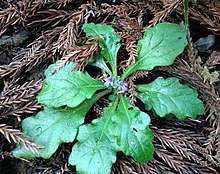Ajuga decumbens
Ajuga decumbens is a herbaceous flowering plant native to China, Japan and Korea. It is commonly found in lightly forested sunny areas, such as meadows and roadsides between 400–2300 metres in altitude.[2] This plant grows as a groundcover, and the leaf layer is usually no more than 100 millimetres (3.9 inches) tall. It flowers between April and June.[3]
| Ajuga decumbens | |
|---|---|
 | |
| Scientific classification | |
| Kingdom: | Plantae |
| Clade: | Tracheophytes |
| Clade: | Angiosperms |
| Clade: | Eudicots |
| Clade: | Asterids |
| Order: | Lamiales |
| Family: | Lamiaceae |
| Genus: | Ajuga |
| Species: | A. decumbens |
| Binomial name | |
| Ajuga decumbens | |
| Synonyms[1] | |
| |
Description
The purple to white erect flower stems can grow to 30 cm (12 in) tall, and are hermaphroditic. The corolla is straight, tubular and 8 mm (0.31 in) long. Petals are 5–8 mm (0.20–0.31 in) long. The leaves are purplish green and are 3–6 cm (1.2–2.4 in) wide to 1.5–2.5 cm (0.59–0.98 in) long.[2] The entire plant is analgesic, decoagulant, depurative, febrifuge and haemostatic, and is used internally to relieve bladder ailments, whilst it is used externally to treat burns and cuts.[4]
References
- "Ajuga decumbens Thunb". The Plant List. 2013. Retrieved 27 August 2018.
- "Flora of China". e.Floras.org. Retrieved 27 August 2018.
- "Ajuga decumbens PFAF Database". Plants for a Future. Retrieved 27 August 2018.
- "Medicinal use of Ajuga decumbens". naturalmedicinalherbs.net. Retrieved 27 August 2018.
External links
![]()